Asus PU500CA User Manual
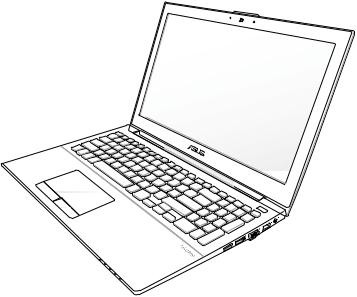
E7837
Notebook PC User Manual
December 2012

Table of Contents |
|
|
Chapter 1: |
Introducing the Notebook PC |
|
About This User’s Manual................................................................................. |
6 |
|
Notes for This Manual........................................................................................ |
6 |
|
Safety Precautions.............................................................................................. |
7 |
|
Preparing your Notebook PC........................................................................ |
11 |
|
Chapter 2: |
Knowing the parts |
|
Top Side................................................................................................................ |
|
14 |
Bottom Side........................................................................................................ |
|
17 |
Right Side............................................................................................................. |
|
19 |
Left Side................................................................................................................ |
|
21 |
Front Side............................................................................................................. |
|
22 |
Chapter 3: |
Getting Started |
|
Power System..................................................................................................... |
|
24 |
Using AC Power................................................................................................ |
24 |
|
Using Battery Power....................................................................................... |
26 |
|
Battery Care....................................................................................................... |
26 |
|
Powering on the Notebook PC................................................................... |
27 |
|
The Power-On Self Test (POST)................................................................... |
27 |
|
Checking Battery Power............................................................................... |
29 |
|
Charging the Battery Pack........................................................................... |
30 |
|
Power Options.................................................................................................. |
31 |
|
Power Management Modes........................................................................ |
33 |
|
Sleep and Hibernate...................................................................................... |
33 |
|
Thermal Power Control................................................................................. |
34 |
|
Special Keyboard Functions.......................................................................... |
35 |
|
Hot Keys ............................................................................................................. |
|
35 |
Numeric keypad (on selected models).................................................... |
37 |
|
Button and Status Indicators........................................................................ |
38 |
|
Button ............................................................................................................. |
|
38 |
Status Indicators.............................................................................................. |
39 |
|
Notebook PC User Manual

Chapter 4: |
Using the Notebook PC |
|
Pointing Device. |
................................................................................................ |
42 |
Using the .Touchpad ...................................................................................... |
43 |
|
Touchpad .....................................................................Usage Illustrations |
44 |
|
Caring for ...............................................................................the Touchpad |
47 |
|
Memory Card .....................................................................................Reader |
48 |
|
Network Connections..................................................................................... |
49 |
|
Wired Network .......................................................................Connections |
49 |
|
Wireless Network .................................................................Connections |
51 |
|
Bluetooth .......................Wireless Connection (on selected models) |
55 |
|
Instant On............................................................................................................ |
|
57 |
Appendix |
|
|
Optional Accessories..................................................................................... |
A-2 |
|
Optional Connections................................................................................. |
A-2 |
|
Operating System ...............................................................and Software |
A-3 |
|
System BIOS ...................................................................................Settings |
A-4 |
|
Troubleshooting ........................................................................................ |
A-10 |
|
Recovery options .............................................for your Notebook PC |
A-15 |
|
Using Recovery .........................................................................Partition |
A-15 |
|
Using DVD ......................................Recovery (on selected models) |
A-16 |
|
DVD-ROM Drive ........................Information (on selected models) |
A-18 |
|
Blu-ray ROM Drive ....................Information (on selected models) |
A-20 |
|
Internal Modem ...................................................................Compliancy |
A-21 |
|
Declarations and .....................................................Safety Statements |
A-25 |
|
Federal Communications ........................Commission Statement |
A-25 |
|
FCC Radio .............Frequency (RF) Exposure Caution Statement |
A-26 |
|
Declaration ..............of Conformity(R&TTE directive 1999/5/EC) |
A-26 |
|
CE Marking................................................................................................... |
A-27 |
|
IC Radiation ..................................Exposure Statement for Canada |
A-27 |
|
Wireless Operation ......................Channel for Different Domains |
A-28 |
|
France Restricted ...................................Wireless Frequency Bands |
A-28 |
|
UL Safety .......................................................................................Notices |
A-30 |
|
Power Safety .....................................................................Requirement |
A-31 |
|
Notebook PC User Manual

TV Notices..................................................................................................... |
A-31 |
REACH ........................................................................................................ |
A-31 |
Nordic Lithium Cautions (for lithium-ion batteries)...................... |
A-32 |
Optical Drive Safety Information.......................................................... |
A-33 |
Service warning label............................................................................... |
A-33 |
CDRH Regulations...................................................................................... |
A-33 |
Macrovision Corporation Product Notice.......................................... |
A-34 |
Regional notice for Singapore............................................................... |
A-34 |
CTR 21 Approval(for Notebook PC with built-in Modem)........... |
A-35 |
European Union Eco-label...................................................................... |
A-36 |
Prevention of Hearing Loss..................................................................... |
A-37 |
Coating Notice............................................................................................ |
A-37 |
Global Environmental Regulation |
|
Compliance and Declaration ................................................................ |
A-38 |
ASUS Recycling/Takeback Services..................................................... |
A-38 |
Regional Notice for United States of America................................. |
A-38 |
Copyright Information............................................................................... |
A-39 |
Limitation of Liability.................................................................................. |
A-40 |
Service and Support................................................................................... |
A-40 |
Notebook PC User Manual
Chapter 1: 1
Introducing the
Notebook PC

About This User’s Manual
You are reading the Notebook PC User’s Manual.This User’s Manual provides information regarding the various components in the Notebook PC and how to use them.The following are major sections of this User’s Manual:
1.Introducing the Notebook PC
Introduces you to the Notebook PC and this User’s Manual.
2.Knowing the Parts
Gives you information on the Notebook PC’s components.
3.Getting Started
Gives you information on getting started with the Notebook PC.
4.Using the Notebook PC
Gives you information on using the Notebook PC’s components.
5.Appendix
Introduces you to optional accessories and gives additional information.
The actual bundled operating system and applications differ by models and territories.There may be differences between your Notebook PC and the pictures shown in this manual. Please accept your Notebook PC as being correct.
Notes for This Manual
A few notes and warnings are used throughout this guide, allowing you to complete certain tasks safely and effectively.These notes have different degrees of importance as follows:
WARNING! Important information that must be followed for safe operation.
IMPORTANT! Vital information that must be followed to prevent damage to data, components, or persons.
TIP: Tips for completing tasks.
NOTE: Information for special situations.
Notebook PC User Manual
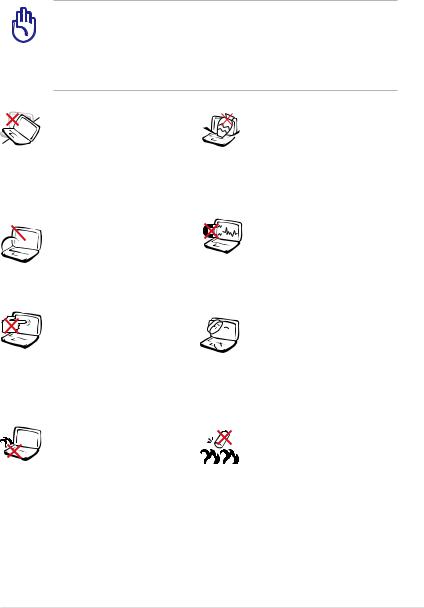
Safety Precautions
The following safety precautions will increase the life of the Notebook PC. Follow all precautions and instructions. Except as described in this manual, refer all servicing to qualified personnel.
Disconnect the AC power and remove the battery pack(s) before cleaning.Wipe the Notebook PC using a clean cellulose sponge or chamois cloth dampened with a solution of nonabrasive detergent and a few drops of warm water and remove any extra moisture with a dry cloth.
DO NOT place on uneven or unstable work surfaces. Seek servicing if the casing has been damaged.

 DO NOT expose to dirty or dusty environments. DO NOT operate during a gas leak.
DO NOT expose to dirty or dusty environments. DO NOT operate during a gas leak.
DO NOT press or touch  the display panel. Do not
the display panel. Do not 


 place together with small
place together with small
items that may scratch or enter the Notebook PC.
DO NOT leave the Notebook PC on your lap or any part of the body to prevent discomfort or injury from heat exposure.
DO NOT place or drop objects on top and do not shove any
foreign objects into the Notebook PC.
DO NOT expose to strong magnetic or electrical fields.
DO NOT expose to or use near liquids, rain, or moisture. DO NOT use the modem during electrical storms.
Battery safety warning: DO NOT throw the battery in fire. DO NOT short circuit the contacts. DO NOT disassemble the battery.
Notebook PC User Manual
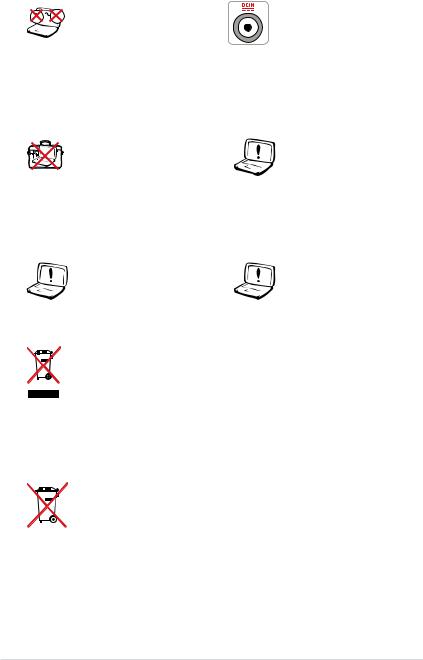





 SAFE TEMP:This
SAFE TEMP:This 
 Notebook PC should only be used in environments with ambient temperatures between 5°C (41°F) and 35°C (95°F).
Notebook PC should only be used in environments with ambient temperatures between 5°C (41°F) and 35°C (95°F).
DO NOT carry or cover a Notebook PC that
is powered on with any materials that will reduce air circulation such as a carrying bag.
DO NOT use damaged power cords, accessories, or other peripherals.
INPUT RATING: Refer to the rating label on the bottom of the Notebook PC and be sure that your power adapter complies with the rating.
DO NOT use strong solvents such as thinners, benzene, or other chemicals on or near the surface.
Incorrect installation of battery may cause explosion and damage the Notebook PC.
DO NOT throw the Notebook PC in municipal waste.This product has been designed to enable proper reuse of parts and recycling.The symbol of the crossed out wheeled bin indicates that the product (electrical, electronic equipment and mercury-containing button cell battery) should not be placed in municipal waste. Check local regulations for disposal of electronic products.
DO NOT throw the battery in municipal waste.The symbol of the crossed out wheeled bin indicates that the battery should not be placed in municipal waste.
Notebook PC User Manual
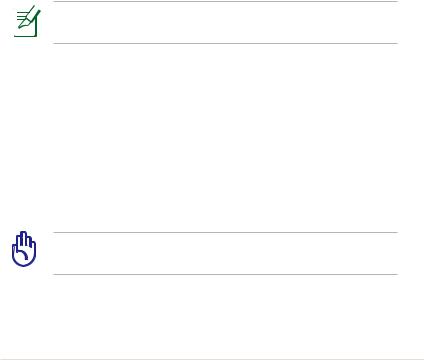
Sound Pressure warning
Excessive sound pressure from earphones or headphones can cause hearing damage or loss. Adjustment of the volume control as well as the equalizer to settings other than the center position may increase the earphones or headphones output voltage and the sound pressure level.
DC Fan warning
Please note that the DC fan is a moving part that may cause DANGER. Ensure to keep your body from the moving fan blades.
Adapter Information
Input voltage: 100-240Vac
Input frequency: 50-60Hz
Rating output current: 3.42A (65W)
Rating output voltage: 19Vdc
The socket-outlet shall be installed near the equipment and shall be easily accessible.
Transportation Precautions
To prepare the Notebook PC for transport, you should turn it off and disconnect all external peripherals to prevent damage to the connectors.The hard disk drive’s head retracts when the power is turned off to prevent scratching of the hard disk surface during transport.Therefore, you should not transport the Notebook PC
while the power is still on. Close the display panel and check that it is latched securely in the closed position to protect the keyboard and display panel.
The Notebook PC’s surface is easily dulled if not properly cared for. Be careful not to rub or scrape the Notebook PC surfaces.
Notebook PC User Manual

Cover Your Notebook PC
Purchase a carrying bag to protect the Notebook PC from dirt, water, shock, and scratches.
Charge Your Batteries
If you intend to use battery power, be sure to fully charge your battery pack and any optional battery packs before going on long trips. Remember that the power adapter charges the battery pack as long as it is plugged into the computer and an AC power source. Be aware that it takes much longer to charge the battery pack when the Notebook PC is in use.
Airplane Precautions
Contact your airline if you want to use the Notebook PC on the airplane. Most airlines will have restrictions for using electronic devices. Most airlines will allow electronic use only between and not during takeoffs and landings.
There are three main types of airport security devices: X-ray machines (used on items placed on conveyor belts), magnetic detectors (used on people walking through security checks), and magnetic wands (hand-held devices used on people or individual items).You can send your Notebook PC and diskettes through airport X-ray machines. However, it is recommended that you do not send your Notebook PC or diskettes through airport magnetic detectors or expose them to magnetic wands.
10 |
Notebook PC User Manual |
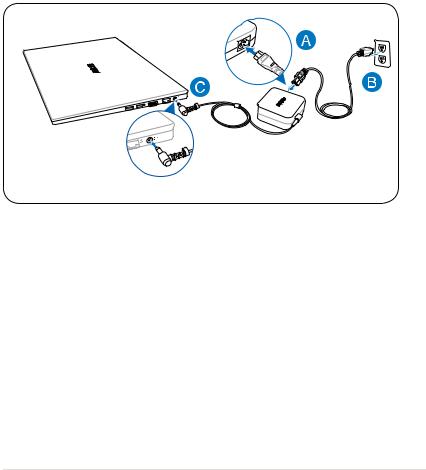
Preparing your Notebook PC
These are only quick instructions for using your Notebook PC.
Connecting the AC power adapter
A.Connect the AC power cord to the AC/DC adapter.
B.Plug the AC power adapter into an electrical outlet (100V-240V)
C.Plug the DC power connector into your Notebook PC.
Notebook PC User Manual |
11 |

Opening the display panel
A.Hold the base of your Notebook PC then lift up the display panel with your thumb.
B.Slowly tilt the display panel forward or backward to a comfortable viewing angle.
Turning the power on
Press the power button.
12 |
Notebook PC User Manual |
Chapter 2: |
2 |
|
|
Knowing the parts |
|
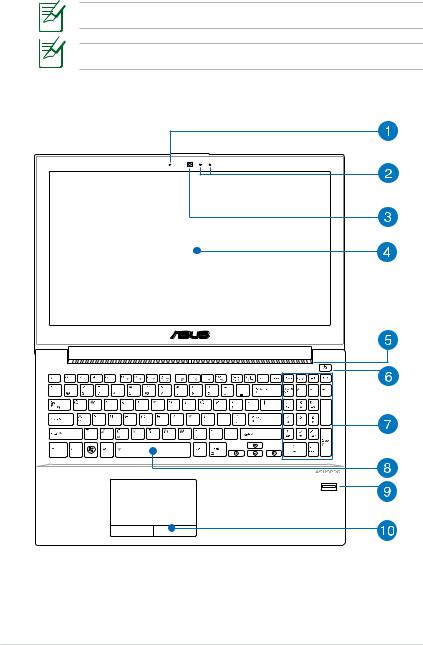
Top Side
The keyboard differs for each territory.
The top side may vary in appearance depending on model.
14 |
Notebook PC User Manual |
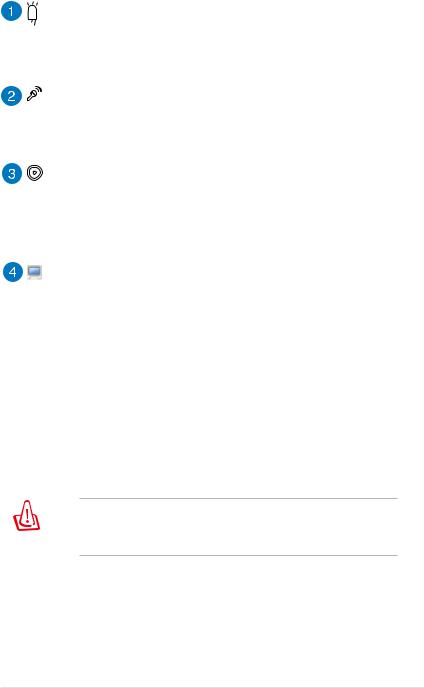
Camera Indicator
The camera indicator shows when the built-in camera is in use.
Microphone (Built-in)
The built-in mono microphone can be used for video conferencing, voice narrations, or simple audio recordings.
Camera
The built-in camera allows picture taking or video recording. Can be used with video conferencing and other interactive applications.
Display Panel
The display panel functions the same as a desktop monitor. The Notebook PC uses a TFT LCD, which provides excellent viewing like that of desktop monitors. Unlike desktop monitors, the LCD panel does not produce any radiation or flickering. Use a soft cloth without chemical liquids (use plain water if necessary) to clean the display panel.
 Air vents
Air vents
The air vents allow cool air to enter and warm air to exit the Notebook PC.
WARNING! Ensure that paper, books, clothing, cables, or other objects do not block any of the air vents or else overheating may occur.
Notebook PC User Manual |
15 |
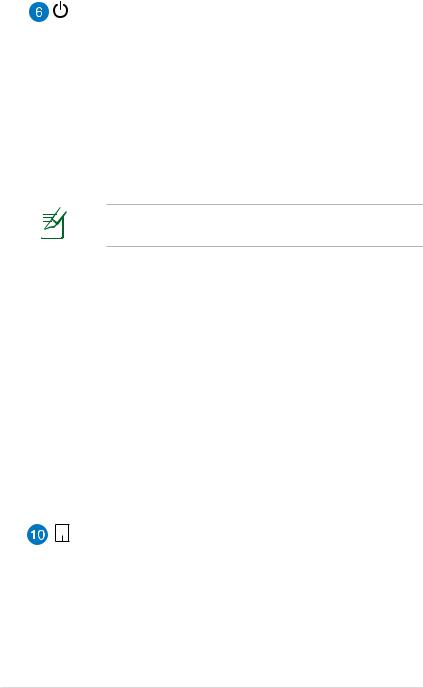
Power Button
The power button turns the Notebook PC on and off, and wakes it up from suspend mode. Press the power button once to turn on and once to turn off the Notebook PC.The power button only works when the display panel is opened.
 Numeric keypad (on selected models)
Numeric keypad (on selected models)
The numeric keypad toggles between these two functions: for numeric input and as pointer direction keys.
For more details, refer to the Numeric keypad section in this manual.
 Keyboard
Keyboard
The keyboard provides full-sized QWERTY keys with a comfortable travel depth for typing and a palm rest for both hands. It also comes with special keyboard functions that can enable hot keys, allow quick access to Windows, and control multimedia functions. For more details, refer to
Special Keyboard functions under Chapter 3.
 Fingerprint scanner (on selected models)
Fingerprint scanner (on selected models)
This Notebook PC’s built-in fingerprint scanners uses a security software that allows you to use your fingerprint as an identification key.
Touchpad
The touchpad is a pointing device that provides the same functions as a desktop mouse. A software-controlled scrolling function is available after setting up the included touchpad utility to allow easy Windows or web navigation.
16 |
Notebook PC User Manual |
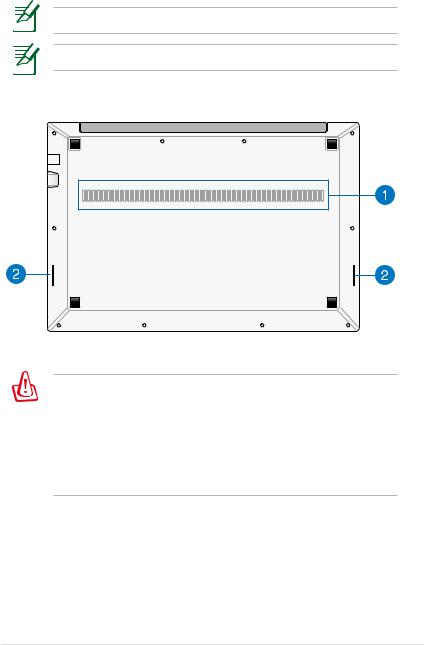
Bottom Side
The bottom side may vary in appearance depending on model.
The battery pack size varies depending on model.
The bottom of the Notebook PC can get very hot. Be careful when handling the Notebook PC while it is in operation or recently been in operation. High temperatures are normal during charging or operation. DO NOT USE on SOFT SURFACES SUCH
AS BEDS OR SOFAS WHICH MAY BLOCK THE VENTS. DO NOT PUT THE NOTEBOOK PC on YOUR LAP OR OTHER PARTS OF THE BODY TO AVOID INJURY FROM THE HEAT.
Notebook PC User Manual |
17 |
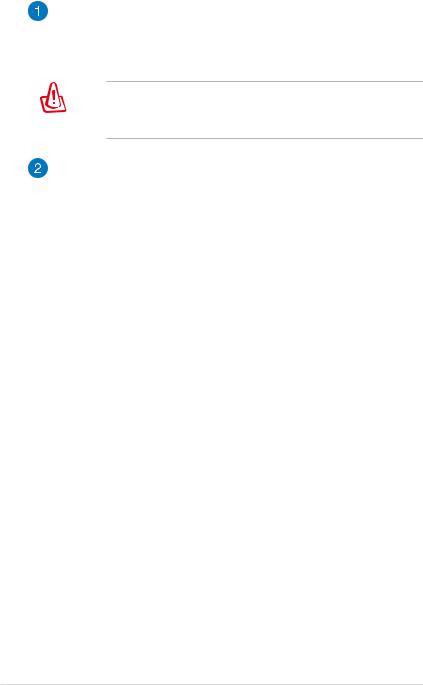
Air vents
The air vents allow cool air to enter and warm air to exit the Notebook PC.
WARNING! Ensure that paper, books, clothing, cables, or other objects do not block any of the air vents or else overheating may occur.
Audio speakers
The built-in audio speakers allow you to hear audio straight from the Notebook PC.The audio features of this Notebook PC are software-controlled.
18 |
Notebook PC User Manual |
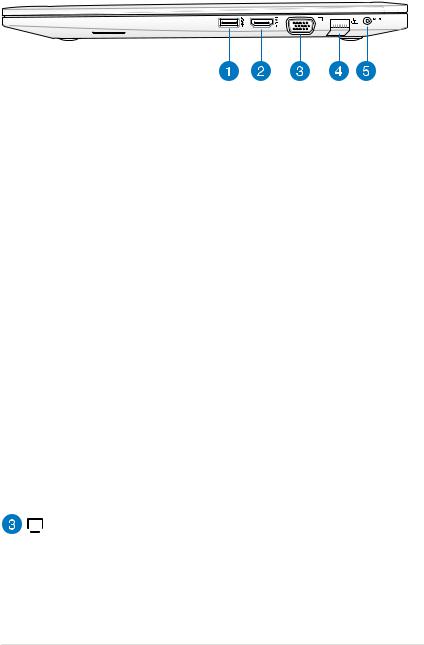
Right Side

 USB Port (3.0, on selected models / 2.0)
USB Port (3.0, on selected models / 2.0)
The USB (Universal Serial Bus) port is compatible with USB 3.0, 2.0, or USB 1.1 devices such as keyboards, pointing devices, cameras, hard disk drives, printers, and scanners connected in a series up to 4.8Gbits/sec (USB 3.0), 480Mbits/sec (USB 2.0), and 12Mbits/sec (USB 1.1). USB allows many devices to run simultaneously on a single computer, with some peripherals acting as additional plug-in sites or hubs. USB supports hot-swapping of devices so that most peripherals can be connected or disconnected without restarting the computer.
 HDMI HDMI Port
HDMI HDMI Port
HDMI (High-Definition Multimedia Interface) is an uncompressed all-digital audio/video interface between an audio/video source and an audio and/or video monitor. HDMI supports standard, enhanced, or high-definition video, plus multi-channel digital audio on a single cable. It transmits all ATSC HDTV standards and supports 8-channel digital audio, with bandwidth to spare to accommodate future enhancements or requirements.
Display (Monitor) Output
The 15-pin D-sub monitor port supports a standard VGAcompatible device such as a monitor or projector to allow viewing on a larger external display.
Notebook PC User Manual |
19 |
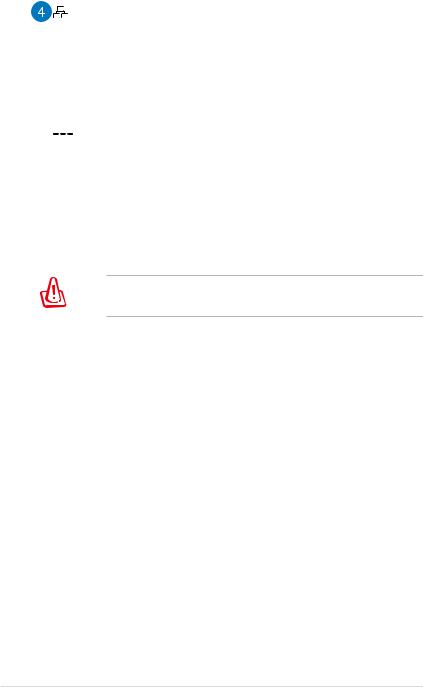
LAN Port
The RJ-45 LAN port with eight pins is larger than the RJ-11 modem port and supports a standard Ethernet cable for connection to a local network.The built-in connector allows convenient use without additional adapters.


 Power (DC) Input
Power (DC) Input
The supplied power adapter converts AC power to DC power for use with this jack. Power supplied through this jack supplies power to the Notebook PC and charges the internal battery pack.To prevent damage to the Notebook PC and battery pack, always use the supplied power adapter.
The adapter may become warm to hot when in use. Ensure not to cover the adapter and keep it away from your body.
20 |
Notebook PC User Manual |
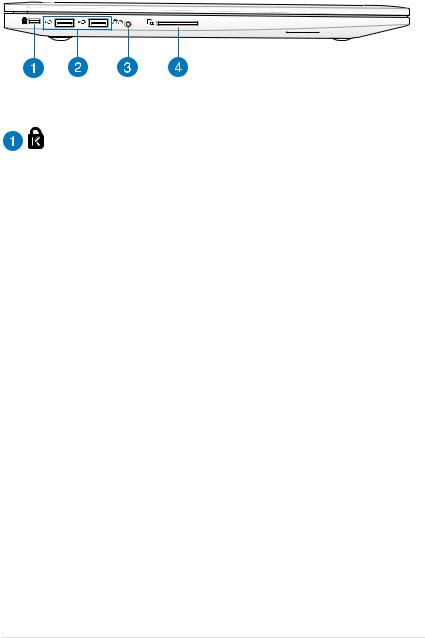
Left Side
Kensington® Lock Port
The Kensington® lock port allows the Notebook PC to be secured using Kensington® compatible Notebook PC
security products.These security products usually include a metal cable and lock that prevent the Notebook PC to be removed from a fixed object. Some may also include a motion detector to sound an alarm when moved.

 USB Ports (2.0)
USB Ports (2.0)
These USB (Universal Serial Bus) ports are compatible with USB 2.0 or USB 1.1 devices such as keyboards, pointing devices, cameras, hard disk drives, printers, and scanners connected in a series up to 12Mbits/sec (USB 1.1) and 480Mbits/sec (USB 2.0). USB allows many devices to run simultaneously on a single computer, with some peripherals acting as additional plug-in sites or hubs. USB
supports hot-swapping of devices so that most peripherals can be connected or disconnected without restarting the computer.
Notebook PC User Manual |
21 |
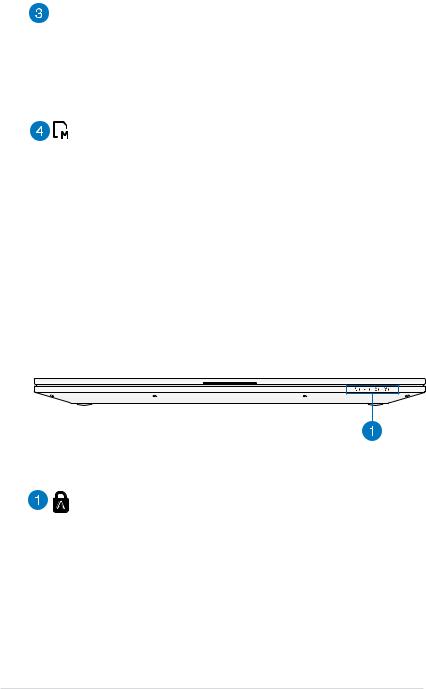
Headphone output/microphone input combo jack port
This port allows you to connect your Notebook PC to amplified speakers or headphones.You can also use this port to connect your Notebook PC to an external microphone.
Memory Card Reader
Normally an external memory card reader must be purchased separately in order to use memory cards from devices such as digital cameras, MP3 players, and mobile phones.This Notebook PC has a built-in high-speed memory card reader that can conveniently read from and write to memory cards.
Front Side
Status Indicators
Status indicators represent various hardware/software conditions. For detailed information, see Status Indicators in Chapter 3.
22 |
Notebook PC User Manual |
Chapter 3: |
3 |
|
|
Getting Started |
|

Power System
Using AC Power
The Notebook PC power is comprised of two parts, the power adapter and the battery power system.The power adapter converts AC power from a wall outlet to the DC power required by the Notebook PC.Your Notebook PC comes with a universal AC-DC adapter.That means that you may connect the power cord to any 100V-120V as well as 220V-240V outlets without setting switches or using power converters. Different countries may require that an adapter be used to connect the provided US-standard AC power cord to a different standard. Most hotels will provide universal outlets to support different power cords as well as voltages. It is always best to ask an experienced traveler about AC outlet voltages when bringing power adapters to another country.
The actual location of the power input differs by models. Refer to the previous chapter to locate the LAN port.
You can buy travel kits for the Notebook PC that includes power and modem adapters for almost every country.
DO NOT connect the AC power cord to an AC outlet prior to connecting the DC plug to the Notebook PC. Doing so may damage the AC-DC adapter.
24 |
Notebook PC User Manual |
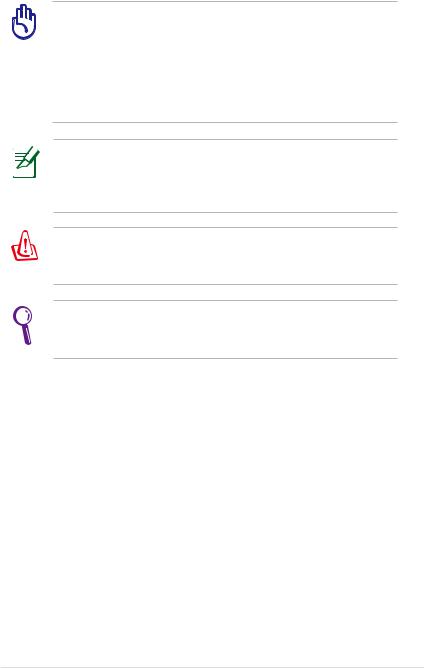
Damage may occur if you use a different adapter to power the Notebook PC or use the Notebook PC’s adapter to power other electrical devices. If there is smoke, burning scent, or extreme heat coming from the AC-DC adapter, seek servicing. Seek servicing if you suspect a faulty AC-DC adapter.You may damage both your battery pack(s) and the Notebook PC with a faulty AC-DC adapter.
This Notebook PC may come with either a two or three-prong plug depending on territory. If a three-prong plug is provided, you must use a grounded AC outlet or use a properly grounded adapter to ensure safe operation of the Notebook PC.
THE POWER ADAPTER MAY BECOME WARM TO HOT WHEN IN USE. BE SURE NOT TO COVER THE ADAPTER AND KEEP IT AWAY FROM YOUR BODY.
Unplug the power adapter or switch off the AC outlet to minimize the power consumption when the Notebook PC is not in use.
Notebook PC User Manual |
25 |

Using Battery Power
The battery pack consists of a set of battery cells housed together. A fully charged pack will provide several hours of battery life, which can be further extended by using power management features through the BIOS setup.
Battery Care
The Notebook PC’s battery pack, like all rechargeable batteries, has a limit on the number times it can be recharged.The battery pack’s useful life will depend on your environment temperature, humidity, and how your Notebook PC is used. It is ideal that the battery be used in a temperature range between 10˚C and 35˚C (50˚F and 95˚F).You must also take into account that the Notebook PC’s internal temperature is higher than the outside temperature. Any temperatures above or below this range will shorten the life of the battery. But in any case, the battery pack’s usage time will eventually decrease and a new battery pack must be purchased from an authorized dealer for this Notebook PC. Because batteries also have a shelf life, it is not recommended to buy extras for storing.
For safety reasons, DO NOT throw the battery in fire, DO NOT short circuit the contacts, and DO NOT disassemble the battery. If there is any abnormal operation or damage to the battery pack caused by impact, turn off the Notebook PC and contact an authorized service center.
26 |
Notebook PC User Manual |
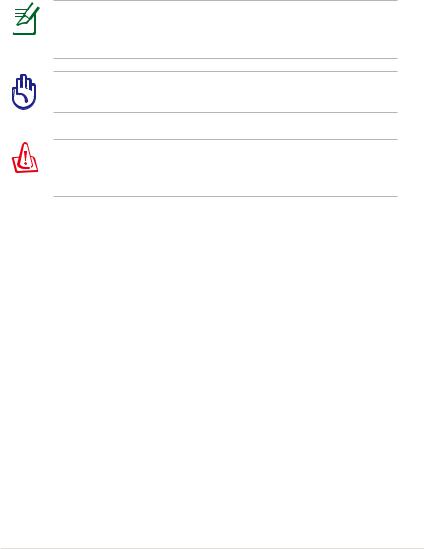
Powering on the Notebook PC
The Notebook PC’s power-on message appears on the screen when you turn it on. If necessary, you may adjust the brightness by using the hot keys. If you need to run the BIOS Setup to set or modify
the system configuration, press [f2] upon bootup to enter the BIOS Setup. Press [esc] and you will be presented with a boot menu with selections to boot from your available drives.
Before bootup, the display panel flashes when the power is turned on.This is part of the Notebook PC’s test routine and is not a problem with the display.
To protect the hard disk drive, always wait at least 5 seconds after turning off your Notebook PC before turning it back on.
DO NOT carry or cover a Notebook PC that is powered on with any materials that will reduce air circulation such as a carrying bag.
The Power-On Self Test (POST)
When you turn on the Notebook PC, it will first run through a series of software-controlled diagnostic tests called the Power-On Self Test (POST).The software that controls the POST is installed as a permanent part of the Notebook PC’s architecture.The POST includes a record of the Notebook PC’s hardware configuration,
which is used to make a diagnostic check of the system.This record is created by using the BIOS Setup program. If the POST discovers a difference between the record and the existing hardware, it will display a message on the screen prompting you to correct the conflict by running BIOS Setup. In most cases the record should be
correct when you receive the Notebook PC.When the test is finished, you may get a message reporting “No operating system found”if the hard disk was not preloaded with an operating system.This indicates that the hard disk is correctly detected and ready for the installation of a new operating system.
Notebook PC User Manual |
27 |
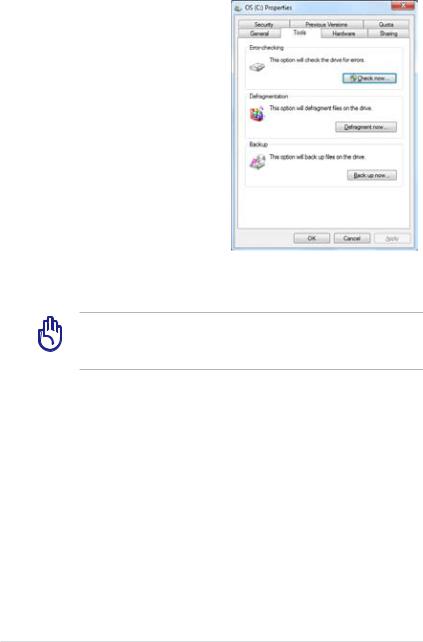
Self Monitoring and Reporting Technology
The S.M.A.R.T. (Self Monitoring and Reporting Technology) checks the hard disk drive during POST and gives a warning message if the hard disk drive requires servicing. If any critical hard disk drive warning is
given during bootup, backup your data immediately and run Windows disk checking program. To run Window’s disk checking program: click Windows > select Computer > right-click
a hard disk drive icon > choose
Properties > click the Tools tab >
click Check Now > click Start.You can also select “Scan ... sectors”for more effective scan and repair but the process will run slower.
If warnings are still given during bootup after running a software disk checking utility, you should take your Notebook PC in for servicing. Continued use may result in data loss.
28 |
Notebook PC User Manual |
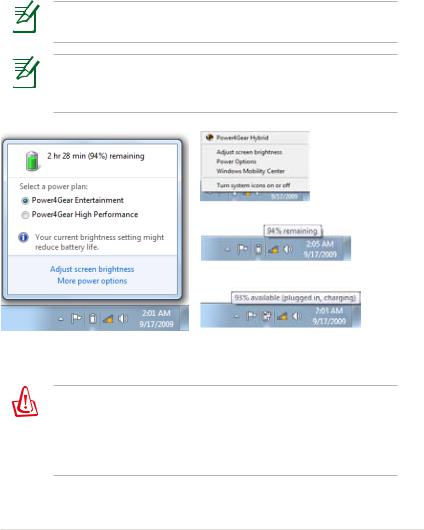
Checking Battery Power
The battery system implements the Smart Battery standard under the Windows environment, which allows the battery to accurately report the amount of charge left in the battery. A fully-charged battery pack provides the Notebook PC a few hours of working power. But the actual figure varies depending on how you use the power saving features, your general work habits, the CPU, system memory size, and the size of the display panel.
Screen captures shown here are examples only and may not reflect what you see in your system.
You will be warned when battery power is low. If you continue to ignore the low battery warnings, the Notebook PC eventually enters suspend mode (Windows default uses STR).
Right-click the battery icon
Pointer over the battery icon without power adapter.
Left-click the battery icon |
Pointer over the battery icon with |
|
power adapter. |
Suspend-to-RAM (STR) does not last long when the battery power is depleted. STR is not the same as power off. STR requires a small amount of power and will fail and lose data if no power is available due to complete battery depletion or no power supply (e.g. removing both the power adapter and battery pack).
Notebook PC User Manual |
29 |

Charging the Battery Pack
Before you use your Notebook PC on the road, you will have to charge the battery pack.The battery pack begins to charge as soon as the Notebook PC is connected to external power using the power adapter. Fully charge the battery pack before using it for the first time. A new battery pack must completely charge before the Notebook PC is disconnected from external power. It takes a few hours to fully charge the battery when the Notebook PC is turned
off and may take twice the time when the Notebook PC is turned on. The battery status indicator on the Notebook PC turns off when the battery pack is charged.
The battery starts charging when the charge remaining in the battery drops below 95%.This prevents the battery from charging frequently. Minimizing the recharge cycles helps prolong battery life.
The battery stops charging if the temperature is too high or the battery voltage is too high.
DO NOT leave the battery pack discharged.The battery pack will discharge over time. If not using a battery pack, it must continued to be charged every three months to extend recovery capacity or else it may fail to charge in the future.
30 |
Notebook PC User Manual |
